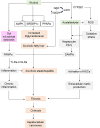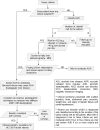Epidemiological Realities of Alcoholic Liver Disease: Global Burden, Research Trends, and Therapeutic Promise
- PMID: 32690129
- PMCID: PMC7650014
- DOI: 10.3727/105221620X15952664091823
Epidemiological Realities of Alcoholic Liver Disease: Global Burden, Research Trends, and Therapeutic Promise
Abstract
Globally, alcohol consumption contributes to more than 3 million deaths each year. While much of its ramifications is preventable, a coherent public health discourse on how to limit alcohol-related harm has been overdue. By synthesizing information from national and global databases, we show in this analysis that alcohol consumption level and alcohol-attributable burden of diseases, particularly alcoholic liver disease (ALD), are intimately linked to national income distribution, cultural norms, religion, sex, age, and health status. Prevalence and burden of ALD are positively associated with economic standing in most countries, which necessitate active governmental control via cost-effective policies, such as the best buys proposed by the World Health Organization. To date, a number of critical questions remain unanswered over the molecular mechanisms underlying ALD pathophysiology; the insights gained thereof should provide new opportunities for the advancement of novel diagnostic and management strategies. In comparison with other prevailing liver diseases (e.g., viral hepatitis and nonalcoholic fatty liver disease), governmental support to ALD investigation has been sluggish in most Western countries and China, resulting in a dearth of breakthroughs on both the basic and clinical research fronts in the past decades. Emerging foci of clinical trials for ALD therapy include empirical use of probiotics, antioxidants, growth factors, monoclonal antibodies against key inflammatory mediators, and technology-enhanced behavioral interventions. In this article, we seek to provide a comprehensive analysis on the progress and challenges in tackling ALD as a global health problem, with particular emphasis on global disease burden, socioeconomic influences, research trends, government roles, and future therapies.
Figures







Similar articles
-
Trends in the management and burden of alcoholic liver disease.J Hepatol. 2015 Apr;62(1 Suppl):S38-46. doi: 10.1016/j.jhep.2015.03.006. J Hepatol. 2015. PMID: 25920088 Free PMC article. Review.
-
Current Status of Alcoholic Liver Disease in Japan and Therapeutic Strategy.Nihon Arukoru Yakubutsu Igakkai Zasshi. 2016 Aug;51(2):71-90. Nihon Arukoru Yakubutsu Igakkai Zasshi. 2016. PMID: 30462383 Review.
-
Growing burden of alcoholic liver disease in China: A review.World J Gastroenterol. 2019 Mar 28;25(12):1445-1456. doi: 10.3748/wjg.v25.i12.1445. World J Gastroenterol. 2019. PMID: 30948908 Free PMC article. Review.
-
Global epidemiology of alcohol-related liver disease, liver cancer, and alcohol use disorder, 2000-2021.Clin Mol Hepatol. 2025 Apr;31(2):525-547. doi: 10.3350/cmh.2024.0835. Epub 2025 Jan 9. Clin Mol Hepatol. 2025. PMID: 39788109 Free PMC article.
-
Socio-economic association of alcohol use disorder and cardiovascular and alcohol-associated liver disease from 2010 to 2019.Aliment Pharmacol Ther. 2024 Aug;60(3):340-349. doi: 10.1111/apt.18095. Epub 2024 May 29. Aliment Pharmacol Ther. 2024. PMID: 38808961
Cited by
-
SENP2 Reduces Hepatocellular Carcinoma Stemness and Improves Sorafenib Sensitivity Through Inactivating the AKT/GSK3β/CTNNB1 Pathway.Front Oncol. 2021 Dec 7;11:773045. doi: 10.3389/fonc.2021.773045. eCollection 2021. Front Oncol. 2021. PMID: 34950583 Free PMC article.
-
A Transformative Journey Through Support Group Participation: Narratives of the Wives of Individuals With Alcohol Use Disorder.Cureus. 2024 Apr 2;16(4):e57461. doi: 10.7759/cureus.57461. eCollection 2024 Apr. Cureus. 2024. PMID: 38699092 Free PMC article.
-
Magnetic Fields Affect Alcoholic Liver Disease by Liver Cell Oxidative Stress and Proliferation Regulation.Research (Wash D C). 2023;6:0097. doi: 10.34133/research.0097. Epub 2023 Mar 30. Research (Wash D C). 2023. PMID: 37011274 Free PMC article.
-
Phytochemicals Targeting Inflammatory Pathways in Alcohol-Induced Liver Disease: A Mechanistic Review.Pharmaceuticals (Basel). 2025 May 11;18(5):710. doi: 10.3390/ph18050710. Pharmaceuticals (Basel). 2025. PMID: 40430529 Free PMC article. Review.
-
ADAM8 promotes alcoholic liver fibrosis through the MAPK signaling pathway.J Physiol Sci. 2024 Oct 16;74(1):52. doi: 10.1186/s12576-024-00943-2. J Physiol Sci. 2024. PMID: 39407108 Free PMC article.
References
-
- Louvet A, Mathurin P. Alcoholic liver disease: Mechanisms of injury and targeted treatment. Nat Rev Gastroenterol Hepatol. 2015;12(4):231–42. - PubMed
-
- Xiao J, Wang F, Wong NK, He J, Zhang R, Sun R, Xu Y, Liu Y, Li W, Koike K, He W, You H, Miao Y, Liu X, Meng M, Gao B, Wang H, Li C. Global liver disease burdens and research trends: Analysis from a Chinese perspective. J Hepatol. 2019;71(1):212–21. - PubMed
Publication types
MeSH terms
LinkOut - more resources
Full Text Sources
Miscellaneous
